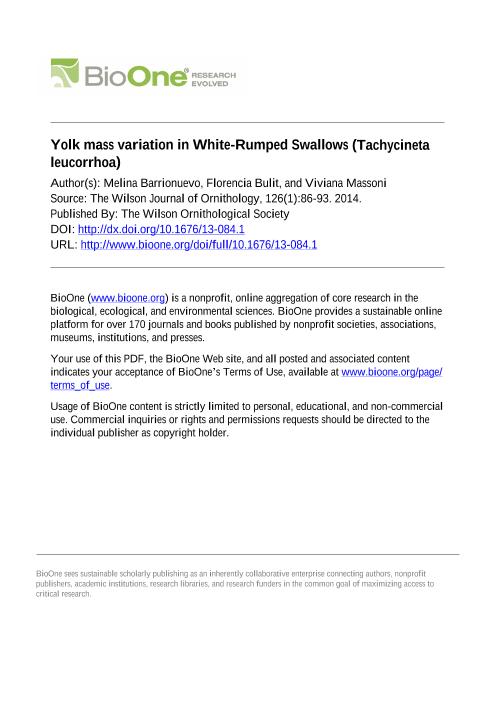Mostrar el registro sencillo del ítem
dc.contributor.author
Barrionuevo, Melina

dc.contributor.author
Bulit, Florencia

dc.contributor.author
Massoni, Viviana

dc.date.available
2017-12-28T19:25:52Z
dc.date.issued
2014-03
dc.identifier.citation
Massoni, Viviana; Bulit, Florencia; Barrionuevo, Melina; Yolk mass variation in White-rumped Swallows (Tachycineta leucorrhoa); Wilson Ornithological Society; Wilson Journal of Ornithology; 126; 1; 3-2014; 86-93
dc.identifier.issn
1559-4491
dc.identifier.uri
http://hdl.handle.net/11336/31868
dc.description.abstract
Egg mass production is costly, but hatching from heavier eggs could be beneficial for the nestling's phenotype and fitness. Egg mass could be influenced by proximate causes, like food abundance, female condition, environmental conditions, and/or by ultimate causes, such as females depositing resources differentially within a clutch to increase the biological fitness of some eggs. Yolk mass, although poorly studied, is the source of nutrients for the embryo, so its mass should be more influential for the nestlings than total egg mass. We used a technique that allowed us to measure yolk size without destroying the eggs. We studied yolk mass in 212 eggs of White-rumped Swallows (Tachycineta leucorrhoa) and found that yolk mass was influenced by laying order, with last laid eggs having heavier yolks than first laid eggs, and the pattern was consistent with egg mass variation. Food abundance also affected yolk mass: when insect availability was high the yolks were heavier. We conclude that embryos in the last laid eggs have more resources from which to develop, and excluding food abundance, neither environmental conditions nor female's condition affected yolk mass. We encourage other researchers to study yolk mass given that multiple variables affected total egg mass.
dc.format
application/pdf
dc.language.iso
eng
dc.publisher
Wilson Ornithological Society

dc.rights
info:eu-repo/semantics/openAccess
dc.rights.uri
https://creativecommons.org/licenses/by-nc-sa/2.5/ar/
dc.subject
Yolk Mass
dc.subject
Egg Mass
dc.subject
Tachycineta Leucorrhoa
dc.subject
Food Abundance
dc.subject
Proximate Causes
dc.subject.classification
Otras Ciencias Biológicas

dc.subject.classification
Ciencias Biológicas

dc.subject.classification
CIENCIAS NATURALES Y EXACTAS

dc.title
Yolk mass variation in White-rumped Swallows (Tachycineta leucorrhoa)
dc.type
info:eu-repo/semantics/article
dc.type
info:ar-repo/semantics/artículo
dc.type
info:eu-repo/semantics/publishedVersion
dc.date.updated
2017-12-27T15:20:17Z
dc.journal.volume
126
dc.journal.number
1
dc.journal.pagination
86-93
dc.journal.pais
Estados Unidos

dc.journal.ciudad
Chicago
dc.description.fil
Fil: Barrionuevo, Melina. Universidad de Buenos Aires. Facultad de Ciencias Exactas y Naturales. Departamento de Ecología, Genética y Evolución; Argentina. Universidad Nacional de la Patagonia Austral. Unidad Académica Caleta Olivia. Centro de Investigaciones Puerto Deseado; Argentina. Consejo Nacional de Investigaciones Científicas y Técnicas; Argentina
dc.description.fil
Fil: Bulit, Florencia. Consejo Nacional de Investigaciones Científicas y Técnicas; Argentina. Universidad de Buenos Aires. Facultad de Ciencias Exactas y Naturales. Departamento de Ecología, Genética y Evolución; Argentina
dc.description.fil
Fil: Massoni, Viviana. Consejo Nacional de Investigaciones Científicas y Técnicas; Argentina. Universidad de Buenos Aires. Facultad de Ciencias Exactas y Naturales. Departamento de Ecología, Genética y Evolución; Argentina
dc.journal.title
Wilson Journal of Ornithology

dc.relation.alternativeid
info:eu-repo/semantics/altIdentifier/url/http://www.bioone.org/doi/abs/10.1676/13-084.1
dc.relation.alternativeid
info:eu-repo/semantics/altIdentifier/doi/http://dx.doi.org/10.1676/13-084.1
Archivos asociados
